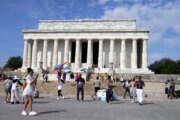TOKYO (AP) — Japan’s Nikkei 225 stock index plunged more than 12% on Monday as investors worried that the U.S. economy may be in worse shape than had been expected and dumped a wide range of shares.
The Nikkei index fell 4,451.28 points to 31,458.42. It dropped 5.8% on Friday and has now logged its worst two-day decline ever, dropping 18.2% in the last two trading sessions.
At its lowest, the Nikkei plunged as much as 13.4% on Monday. Its biggest single-day rout was a drop of 3,836 points, or 14.9%, on the day dubbed “Black Monday” in October 1987. It suffered an 11.4% drop in October 2008 during the global financial crisis and fell 10.6% in the aftermath of a massive earthquake and nuclear meltdowns in northeastern Japan in March 2011.
Monday’s decline was the second largest percentage loss in a single day and the largest ever loss in terms of points.
Share prices have fallen in Tokyo since the Bank of Japan raised its benchmark interest rate on Wednesday. The Nikkei index is now about 3.8% below the level it was at a year ago.
The wave of selling hit all sorts of companies.
Toyota Motor Corp.’s shares dropped 13.7% and Honda Motor Co. lost 17.8%. Computer chip maker Tokyo Electron dived 18.5% and Mitsubishi UFJ Financial Group plunged 17.8%.
Analysts said another factor contributing to the falling share prices was carry trades, where investors borrow money from a country with low interest rates and a relatively weak currency, like Japan, and invest those funds in places that will yield a high return. Investors have been selling stocks to repay those loans as their costs have risen with a stronger yen and higher interest rates.
“The surge in financial market volatility was the result of a perfect storm of macro and market shocks at a time when risk assets were already overbought and overstretched,” BMI, a unit of Fitch Solutions, said in a report. It said the Bank of Japan’s July 31 decision to raise its key interest rate “led to a sharp unwind of the yen carry trade, which added downside pressure on risk assets which were already selling off.”
Before raising its benchmark rate last week to 0.25% from 0.1%, the Bank of Japan had kept the overnight call rate on its loans to banks near or below zero for years.
The dollar gained against the yen and other currencies as the Federal Reserve raised its own benchmark rate to a two-decade high to stamp out inflation, and the weaker yen helped push costs higher in Japan, which depends heavily on imports of food, fuel and other necessities.
In its update to Japan’s economic outlook, the central bank said it would “accordingly continue to raise the policy interest rate and adjust the degree of monetary accommodation,” a stance that now is being called into question. So is the decision of the Federal Reserve to keep interest rates steady at least until September.
“The BOJ is arguably in a greater bind, struggling to credibly backtrack on hawkish guidance that has flown out of control, triggering an unintended Nikkei tailspin,” Vishnu Varathan of Mizuho Bank said in an analysis.
Calls to “keep calm and carry on” won’t fly, he said. “But to avoid self-reinforcing panic is perhaps the more critical thing for markets to avert a deeper sell-down.”
Copyright © 2024 The Associated Press. All rights reserved. This material may not be published, broadcast, written or redistributed.





